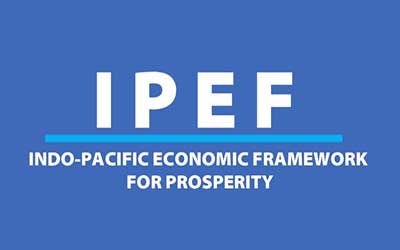Date: 16/05/2023
Relevance: GS-2: Bilateral, Regional, and Global Groupings and Agreements involving India and/or affecting India’s interests.
Key Phrases: Regional Comprehensive Economic Partnership (RCEP), Association of Southeast Asian Nations (ASEAN) grouping, Indo-Pacific Economic Framework for Prosperity (IPEF), Economic Challenges, Vague Language, Economic Impact, four pillars, trade, supply chains, clean economy, and fair economy.
Why in News?
- In November 2019, India walked out from the trade pact called the Regional Comprehensive Economic Partnership (RCEP) involving China, Japan, South Korea, Australia, New Zealand, and the 10-state Association of Southeast Asian Nations (ASEAN) grouping.
- Fast forward to 2023, and now India along with many of the same countries, but with China replaced by the United States, is getting into the U.S.-driven Indo-Pacific Economic Framework for Prosperity (IPEF).
The Devil and deep sea:
- India's Foreign Policy Priorities:
- India's top foreign policy priority is to develop a strategic partnership with the United States.
- However, its relationship with China has deteriorated further, creating a difficult situation for India.
- While a strategic partnership with the U.S. is essential, India must be careful not to become economically dependent on the U.S.
- Economic Challenges with China and the U.S.:
- India's concerns about economic dependency on China centre around cheap Chinese goods flooding Indian markets, which could negatively impact the manufacturing sector.
- Meanwhile, the economic issues with the U.S. also pose significant challenges for India, particularly related to agriculture, intellectual property, labour, environmental standards, and the digital economy.
- The IPEF Proposal and Traditional Trade Deals:
- As trade deals evolve, tariffs are no longer the main focus, with issues like intellectual property, services, investment, domestic regulation, digital, and labour and environmental standards becoming more important.
- The U.S.'s IPEF proposal is an example of this shift, completely removing the tariff element of typical trade deals and focusing on these other areas.
- However, traditional trade deals in the U.S. face likely roadblocks in the legislature.
- In response, the U.S. has presented tariffs-free trade deals as a new kind of win-win economic partnership to overcome resistance from many countries, including India, to free trade agreements.
- The IPEF’s Vague Language and Economic Impact:
- The ‘new age’ language of the IPEF proposal creates vague wording that may be difficult to understand.
- While it may not be clear to many, the U.S. strategists who created the proposals can easily decipher their economic impact.
- Early assessments by experts suggest that the IPEF would result in a complete stranglehold over the economic systems of the participating countries, giving the U.S. a complete advantage.
- Developing a Strategic-Economic Bloc:
- The IPEF is aimed at developing a strategic-economic bloc that would centre around the U.S. and exclude China. The proposal aims to create an integrated economic system that would leave little leeway for domestic policies to help a country’s own industrialization. Tight supply chain integration is among the many elements of the IPEF proposal that contribute to this systemic integration.
The IPEF Trade Deal and Its Potentially Dangerous Language:
- Developing country trade negotiators are wary of the IPEF trade deal's seemingly innocent language.
- They have honed their skills to detect problems in traditional free trade agreements, but find it difficult to understand and respond to the sophistry in the IPEF's language.
- The IPEF is set to be concluded by November 2023, despite real engagements only starting late last year.
- The rush to pass the trade deal using seemingly harmless language will trap countries in permanent economy-wide commitments with little policy-making space.
- The true implications of this language will only become clear in the long run.
Four Pillars of IPEF:
- The IPEF has four pillars: trade, supply chains, clean economy, and fair economy.
- Fearful of a possible trap, India has joined the other three pillars but not trade.
- But there is great pressure on it to join trade too, and India could relent.
- Joining the trade pillar is the worst, but the other pillars too contribute to developing hard new economic architectures and structures that are not tariff-based.
The Implications of IPEF:
- The IPEF could have significant implications for agriculture, particularly regarding genetically modified seeds and food.
- Surrendering policy space for regulating Big Tech could have unintended consequences.
- Compromising a comparative advantage in manufacturing due to unfair labour and environmental standards could hurt India's economy.
- The IPEF could also hamper India's ability to create a vibrant domestic ecosystem in emerging areas such as the digital economy and green products.
Conclusion:
- India is facing a strategic dilemma with the IPEF. On the one hand, the initiative could help to strengthen India's ties with the United States. On the other hand, it could also harm India's economy.
- The Indian government will need to carefully weigh the costs and benefits of the IPEF before making a decision.
Source: The Hindu
Mains Question:
Q. Critically analyze the implications of India's potential involvement in the U.S.-driven Indo-Pacific Economic Framework for Prosperity (IPEF) on its economic policies and future prospects, in light of its previous withdrawal from the Regional Comprehensive Economic Partnership (RCEP).






















